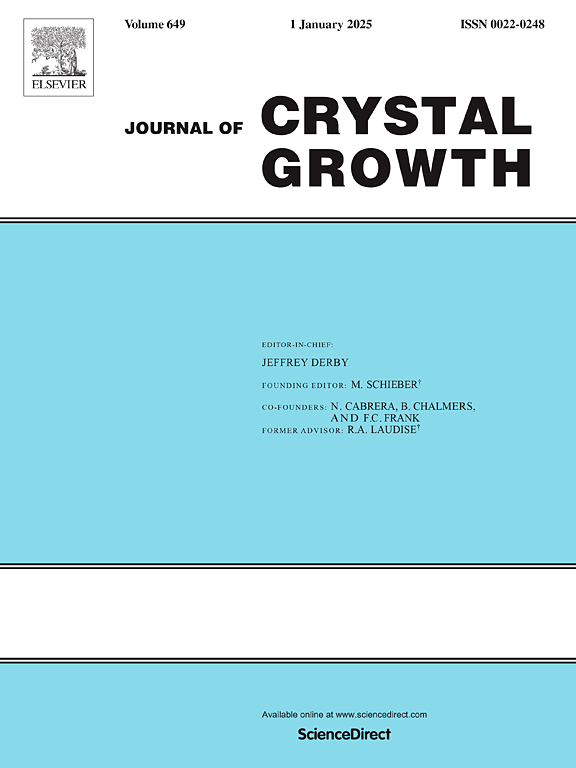抑制卤化物离子迁移的气相沉积法在MAPbBr3单晶上生长FAPbI3薄膜
IF 2
4区 材料科学
Q3 CRYSTALLOGRAPHY
引用次数: 0
摘要
由于卤化物离子的高迁移率和底层钙钛矿在溶液过程中的溶解,实现金属卤化物钙钛矿(MHPs)外延异质结构仍然是一个重大挑战。本文通过FAI和PbI2的共蒸发,在MAPbBr3单晶衬底上实现了FAPbI3薄膜的气相外延生长。使用不同的a位阳离子(FA+用于薄膜,MA+用于衬底)有效抑制界面卤化物离子迁移,使形成稳定的富碘钙钛矿层。结构分析包括x射线衍射、x射线光电子能谱和椭偏光谱,证实了薄膜的外延性质和组成稳定性。互反空间映射揭示了纳米尺度晶粒域之间的松弛外延关系。重要的是,异质结构在70天内保持其结晶度,没有形成δ相FAPbI3,突出了增强的长期稳定性。这些发现为控制MHP外延中的相互扩散提供了见解,并为开发下一代钙钛矿基异质结构开辟了途径。本文章由计算机程序翻译,如有差异,请以英文原文为准。
Epitaxial growth of FAPbI3 thin films on MAPbBr3 single crystals via vapor phase deposition with suppressed halide ion migration
Achieving epitaxial heterostructures of metal halide perovskites (MHPs) remains a significant challenge due to the high mobility of halide ions and the dissolution of underlayer perovskites in solution processes. Here, we demonstrate the vapor-phase epitaxial growth of FAPbI3 thin films on MAPbBr3 single-crystal substrates by co-evaporation of FAI and PbI2. The use of different A-site cations (FA+ for the thin film and MA+ for the substrate) effectively suppressed interfacial halide ion migration, enabling the formation of a stable iodine-rich perovskite layer. Structural analyses including X-ray diffraction, X-ray photoelectron spectroscopy, and spectroscopic ellipsometry confirm the epitaxial nature and compositional stability of the films. Reciprocal space mapping reveals a relaxed epitaxial relationship with nanometer-scale grain domains. Importantly, the heterostructure maintained its crystallinity over 70 days without the formation of δ-phase FAPbI3, highlighting enhanced long-term stability. These findings offer insights into controlling interdiffusion in MHP epitaxy and open pathways for developing next-generation perovskite-based heterostructures.
求助全文
通过发布文献求助,成功后即可免费获取论文全文。
去求助
来源期刊

Journal of Crystal Growth
化学-晶体学
CiteScore
3.60
自引率
11.10%
发文量
373
审稿时长
65 days
期刊介绍:
The journal offers a common reference and publication source for workers engaged in research on the experimental and theoretical aspects of crystal growth and its applications, e.g. in devices. Experimental and theoretical contributions are published in the following fields: theory of nucleation and growth, molecular kinetics and transport phenomena, crystallization in viscous media such as polymers and glasses; crystal growth of metals, minerals, semiconductors, superconductors, magnetics, inorganic, organic and biological substances in bulk or as thin films; molecular beam epitaxy, chemical vapor deposition, growth of III-V and II-VI and other semiconductors; characterization of single crystals by physical and chemical methods; apparatus, instrumentation and techniques for crystal growth, and purification methods; multilayer heterostructures and their characterisation with an emphasis on crystal growth and epitaxial aspects of electronic materials. A special feature of the journal is the periodic inclusion of proceedings of symposia and conferences on relevant aspects of crystal growth.
 求助内容:
求助内容: 应助结果提醒方式:
应助结果提醒方式:


